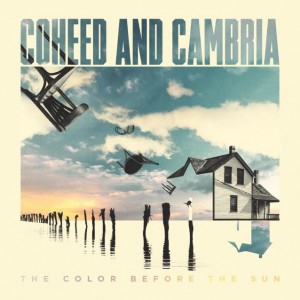
New Coheed and Cambria Album. Photo from Google
Coheed & Cambria released their latest record this month, “The Color Before The Sun,” signifying their departure from their usual conceptual storyline, “The Amory Wars.” The record has earned praise among fans, as well as others citing their disappointment due to its lack of story. It is their arguably most accessible and commercial record yet, while being their most directly personal, heartfelt and emotional record to date — but what makes it truly different, and worth listening to?
According to frontman Claudio Sanchez, “The Color Before The Sun” is his “time capsule of that struggle of identity when writing new material, and the hopefulness that came with fatherhood and the birth of my son.” The album itself was written during a transitional time period in his life. Moving from the wide open and peaceful spaces of upstate New York to an apartment in a noisy, cramped Brooklyn, Sanchez and his wife find themselves confined and compacted into their new home along with the uncertainty of what lies ahead. From wanting to leave the “Island” of Brooklyn for the country home, falling out of his comfort zone in “Eraser” and finding peace within himself in “Colors,” and a love letter to his son who hadn’t even been born yet in “Atlas,” it makes the listener wonder: why didn’t Claudio just do a solo record if he was going to do something autobiographical?
The thing is that their records have always been personal and in their own ways about Claudio’s life. It’s just been hidden behind concepts. Their song “Wake Up” off their third album “Good Apollo, I’m Burning Star IV Volume I” depicts Claudio’s feelings as he leaves his wife to go back on tour: “I’m going to ride this plane/Out of your life again/And I wish that I could stay/But you argue,” but this backfired on Claudio. Chondra wasn’t prepared to put herself in such a situation, to be really into someone and have them be far away from them for a long time, so she broke up with him. The documentary, “The Fiction Will See the Real,” backs this up, stating Claudio’s angst, turning that into a concept in which he further inserts himself within the story as a character that created “The Amory Wars” (On the Writer character). “Things that I’ve gone though, he goes through too. Things that have troubled me, trouble him. But really, when you get down to it, my life experiences have an influence over the story in general. In many ways, I see the story as a metaphor for the band itself.”
In a revealing interview, Claudio discusses the reason he started the series to begin with: “The reason I created ‘The Amory Wars’ so many years ago was because I was a shy guy, and I was afraid to express myself in songs. So I created a fictional world that could take the beating, and I could remain unscathed.” Claudio is now 37, instead of being 24 when he first started, and is much less of the angsty young adult he used to be, and even at the time of their latest album’s release is now a father. He is a much different person now than when he began.
Claudio finally breaking free of his shackles and making peace with himself across this road of self-discovery is what makes “The Color Before The Sun” so important, focusing on himself and not on the story. A concept is all well and fine, but what is the point of not appreciating the band simply and their work because it doesn’t follow a story? The story could not be what it is without Claudio, for all of his storytelling have been his life filtered through his brain into fiction. This time around, pure and direct honesty has resulted into a stripped down, nostalgic and fun, poppy record with helium-filled bombastic choruses that are bound to lift the spirits of the room. Sonically, it is not as elaborate or impressive as previous albums, but it doesn’t hamper the album at all. It stands on its own with a surprising amount of warmth.

Coheed and Cambria band since 2001. Photo from Google
“The Color Before The Sun” does have its serious moments, with the acoustic closer of the first half of the record, “Ghost,” with Claudio wondering what he’s going to be like as a father, to the quintessential heavy-hitter and the most important track off the album, “The Audience.” This song directly addresses the album’s accessibility, and reminds the listener that the old Coheed is far from gone. “The Audience” talks to fans who are on either side of the fence about the album, and whether they love or hate it, Claudio “will still be here when [they’re] done.” Coheed & Cambria will never “march as the beat suggests” and welcomes both fans old and new, citing “This is my audience/Forever one together/Burning stars/Cut from the same disease/Ever longing, what and who we are.” Claudio has left himself open to both the good and the bad criticisms, but is still there for who he feels he owes his career to: his fans, his “audience.”
All in all, what the fans and new listeners take from the album is entirely up to them. While this is Coheed’s first departure from the story, nothing about the heart of the band has really changed. Coheed & Cambria has always been dedicated to its fanbase, and with this album, Claudio simply wants to share with the world what he’s been hiding all along: himself. The best part is that he really doesn’t care about the consequences, but he is open to criticism. The album is worth more than a few listens because of what it has to offer: the road Claudio traveled for a year as an art form might have meaning for us all. Many of us want kids, many don’t, some want to get married, and vice versa. It’s all up to us with the lives we choose. “The Color Before The Sun” offers up its own advice: the things that happen make us who we are, and our problems are no bigger than anyone else’s or our next problems coming up ahead, so accept the bad as part of the good and move forward. This new freedom and self-acceptance is what led Claudio to a much happier place, so why shouldn’t we try it out for ourselves? Food for thought.



